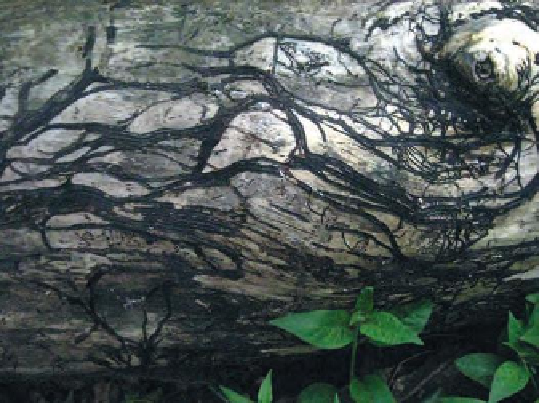Agriculture Reference
In-Depth Information
The much smaller size of these spores allows their
spread
by wind currents. Towards the end of the
summer, spore production changes as teliospore
production becomes more common, giving
the leaf
spots a richer reddish-orange colour. These much
larger spores are carried more easily by rain droplets
than by wind currents.
Hollyhock's related garden species in the family
Malvaceae,
Abutilon, Hibiscus, Lavatera
and
Sidalcea
may be affected by this rust disease. The wild mallow
(
Malva sylvestris
) may also be part of the rust cycle,
especially if it is included as a plant member of a
'wildflower meadow' close to hollyhock plants.
Cultural control
. This is not an easy disease to control
since the tiny basidiospores are easily carried from
garden to garden. Heavily infected plants should be
removed and burnt. Gardeners should not use 'self-
saved seed' as this may be infected by the fungus.
Although hollyhocks are perennials, it is strongly
advised that they be treated as biennials and removed
after their flowering period. If rust disease levels
are low, cut the stems off to ground level in early
autumn and carefully dispose of all above-ground
plant material. Avoid dense stands of hollyhock where
high humidity favours infection. Avoid having other
Malvaceous plants near to hollyhocks.
Chemical control
. Several fungicides such as
difenoconazole
and
myclobutanil
are effective
against the spores of this disease. They also are both
systemic and thus potentially able to control the fungal
mycelium inside the leaf and shoot tissues. However,
the rapid increase of this rust once it becomes
established, and the many spores travelling in from
nearby gardens, often leads to inadequate chemical
control. Regular applications may be needed
twice a
week
to cope with newly arriving spores and newly
expanding leaf tissue. The main advice, if fungicides
are to be used, is that spraying should be started as
early
as possible in mid-May.
Figure 19.15
Honey fungus 'bootlaces' (rhizomorphs)
that enable the fungus to move underground from a
dead stump to infect other plants
serious source of infection for 20 years or more. The
rhizomorphs are the main means of spread for this
disease. The nutrients they are able to conduct provide
the considerable energy required for the infection of
the tough, woody shrub and tree roots. Mycelium
then moves up the stem beneath the bark to a height
of several metres and is visible (when the bark is
pulled away) as white sheets, smelling of mushrooms.
In autumn, clumps of light brown toadstools may
be produced, often at the base of the stem. The
millions of spores produced by the toadstools are not
considered to be important in the infection process.
Honey fungus often establishes itself in newly planted
trees and shrubs that have been planted too deeply.
Too deep planting of shrubs and trees produces less
vigorous plants that are more vulnerable to infection.
Plant vigour is reduced because feeding roots which
ideally should be growing near the surface of the soil
have been located in the relatively infertile subsoil.
Control
. This is difficult. Some genera of plants are
less likely to be infected (see Table 19.1). Removal
of the disease source (the infected stump) is strongly
recommended. The use of a dead tree stump to hold
a bird table is not a good idea. Specialist companies
may be employed to quickly drill out the infected
stump. Alternatively, with large stumps that are hard
to remove, a surrounding trench is sometimes dug to
a depth of 0.7 m (filled with coarse gravel) to prevent
the progress of rhizomorphs.
Honey fungus (
Armillaria mellea
)
This
belongs to the Basidiomycota group of fungi.
Damage
. The fungus primarily attacks trees and shrubs
such as apple, lilac and privet. In spring the foliage
wilts and turns yellow. Death of the plant may take a
few weeks, or several years in large trees. Confirming
symptoms are the toadstools (see Figure 19.1).
Life cycle and spread
. The infection process involves
rhizomorphs (sometimes referred to as 'bootlaces')
that spread out underground from infected trees or
stumps (see Figure 19.15) for a distance of 7 m and
to a depth of 0.7 m. The infected stump may remain a
Bacteria
These minute organisms (see Figure 19.2) measure
about 0.001 mm and occur as single cells that divide

